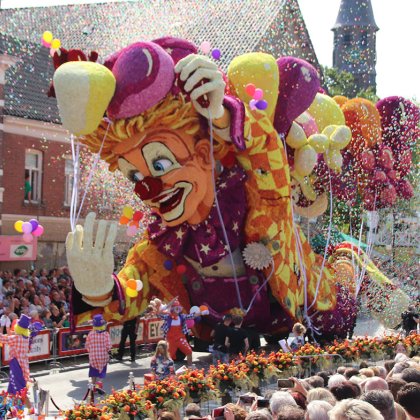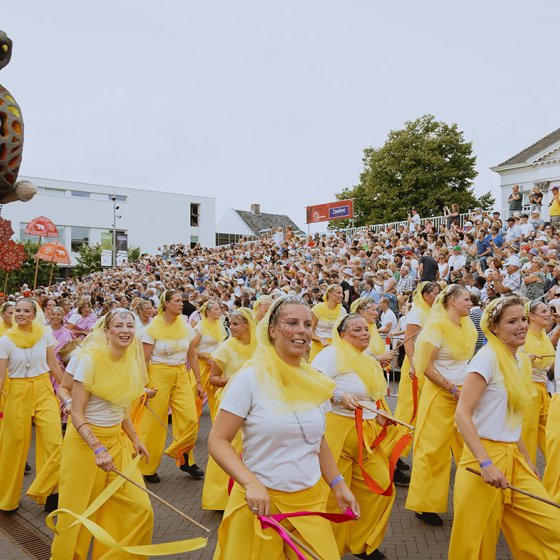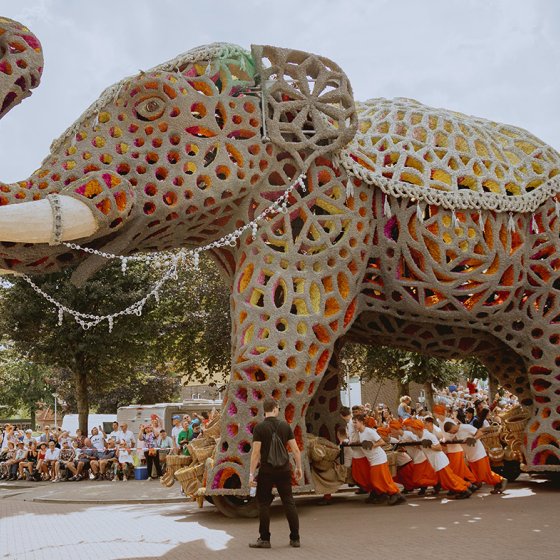
Flower corsos: A colorful tradition
Over each summer, Dutch towns and villages are the setting of spectacular flower parades. Towering sculptures, higher than houses and entirely covered in flowers, slowly pass by on floats, to the delight of throngs of onlookers lining the streets. The parades are often accompanied by marching bands and theatre troupes, and they make a great day out for all involved.
- Learn about the colorful tradition of Dutch flower parades.
- See images of spectacular, gigantic floats.
- Find out when and where to visit a parade.
What would you make if you were tasked with creating a flower sculpture that’s several meters high? A tiger carrying her young? A Viking ship with dragon heads? A giant hedgehog with pencil spines? A burglar, complete with eye mask, torch and loot? No? Well, the Dutch would – and did. All of these sculptures and thousands more have featured in the country’s traditional flower parades, known as bloemencorso’s.

Over each summer, many Dutch towns and villages are the setting of the spectacle offered by these annual parades. Towering sculptures, higher than houses and entirely covered in flowers, slowly pass by on floats, to the delight of throngs of onlookers lining the streets. The parades are often accompanied by marching bands and theatre troupes, and they make a great day out for all involved.
The tradition dates back to the late 18th century and originally came from the south of France and Italy, but the Dutch have made it entirely their own. No wonder, considering the Netherlands is the world’s biggest exporter of flowers, and its flower fields bursting into glorious color each year are among the country’s major attractions. (Read more about the do’s and don’ts of flower tourism here.) Today, in a mark of their status in Dutch culture and history, the flower parades are included on UNESCO’s list of intangible cultural heritage.
Creative competition

Like all the best traditions, this one is a bit eccentric and very serious at the same time. The parades are run as competitions. Floats are usually created by teams from different areas, and winning best float (or one of the subcategories that tend to be awarded) is a huge achievement for those that have participated.
And they are numerous. Hundreds of volunteers are involved in the creation of a float – not surprising, given their size. They often work on the sculptures for months, all leading up to the point when the flowers are attached to the frame in the final few days before the parade. The significance attached to the parades means not just the parade itself, but also the preparation phase are important community events. In the words of UNESCO, “corso culture is about much more than the parade and competition. Having a drink or meal together after working on the floats and organizing regular parties is an important part of the corso, creating a sense of social cohesion and solidarity that is often people’s main motivation for participating in the event.”
Visit a flower parade
Of course, outsiders can witness the wonders of the flower parades, too. As they happen at different points from spring through to fall, visitors to the Netherlands have a good chance to catch one. Here’s a selection:
Bloemencorso Bollenstreek, April
An entire five-day festival springs up around this parade in the heart of the Dutch flower growing region known as the Bollenstreek, with at its center the Saturday parade. Floats decorated with sweet-smelling hyacinths and other spring flowers travel along a 42-kilometer route from Noordwijk to Haarlem, past Sassenheim, Lisse, Hillegom and other villages. All villages and towns in the region get involved in the many activities surrounding the parade. And the floats can also be viewed in Haarlem on the Sunday after the parade. Of course, the time and location of this parade mean it can be perfectly combined with a visit to Keukenhof and the flower fields of the Bollenstreek.
Varend Corso Westland, July
Over the course of three days, the beautifully decorated sailing floats of the Varend Corso Westland parade travel through Naaldwijk, Maassluis, The Hague and Delft. The parade has a different theme each year and there are plenty of great activities along the route.
Rijnsburg Flower Parade, August
Every second Saturday in August, floats, cars decorated with flowers, and music stages move through the streets of Rijnsburg, Katwijk and Noordwijk for the Rijnsburg Flower Parade. Professional flower designers work to incorporate hundreds of flower varieties into these amazing creations, and actors on moving stages perform scenes relevant to the year’s theme.
Parade Sint Jansklooster, August
Every third weekend in August, Sint Jansklooster is a village transformed by theater, music and stunning flower floats. Our tip: there is an illuminated parade on Friday evening, when the floats appear even more magical, decorated with beautiful lights.
Corso Zundert, September
This is the world’s biggest flower parade. Each year, the Corso Zundert takes over the entire village as it prepares to host the most fantastic floats.
Lichtenvoorde Flower Parade, September
Four million dahlias are used to decorate the spectacular floats in the Lichtenvoorde Flower Parade, with hundreds of volunteers working for months to build the giant floats – an impressive feat of craftsmanship.
Future-proofing the flower parades
Despite the strong sense of tradition surrounding the flower parades of the Netherlands, they are also keeping up with the times. An important topic is making the floats and the parades more sustainable. Changes in construction and materials can have a significant impact, especially considering the scale of the floats. The organizers of the Bollenstreek parade have been trialing switching flower foam for mycelium boards. Made from mushroom spores and hemp, they are biodegradable, potentially saving mountains of waste each year. The parade’s efforts to become CO2 neutral also include using LED lighting, and efforts to switch to electric vehicles for the floats. In addition, across all parades there are moves towards innovative designs and reusing materials to aid sustainability. And so, the fantastic creations of the Dutch flower corsos are being future proofed so they can continue to parade past excited onlookers for many decades to come.
